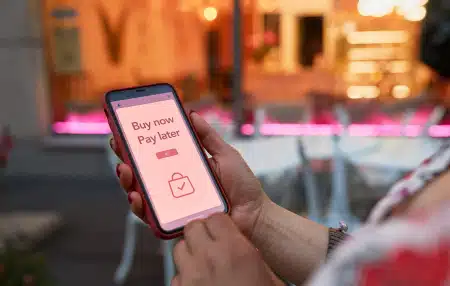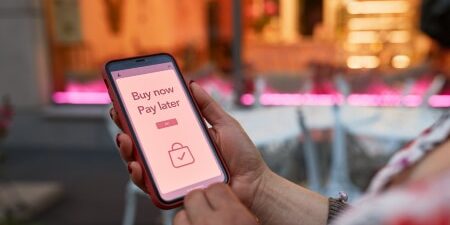
In recent years Buy Now, Pay Later (BNPL) services have grown in popularity, allowing consumers to make purchases without paying the full cost straight away. While splitting the payment over a period may seem like a good way to make larger purchases more manageable or unexpected expenses easier to afford, there are potential drawbacks to consider. A change in circumstances or simply taking out too many BNPL can have a major impact on your finances and you could find yourself struggling to pay these back.
Data from Finder shows that around 50% of adults in the UK have used BNPL services as of 2024, approximately 26.4 million people. This is up from 36% at the beginning of 2023. This increase in usage is affecting peoples’ finances, with 41% of new MoneyPlus customers in January 2024 having BNPL debts.
In this article, we explore the rapid growth of BNPL, why people are using these services and getting into debt, and what the future of this financing option looks like.
The rapid growth of BNPL
While postponed payments date back to the 19th century, BNPL, as we know it today, has grown rapidly in recent years due to the increase in online shopping, a desire for instant gratification, and the appeal of interest-free periods.
Technological advancements have transformed how consumers approach purchases, with BNPL services using digital and mobile platforms that offer user-friendly interfaces and self-service options as a convenient alternative to other payment methods like credit cards. This can particularly affect younger consumers who are more likely to use mobile technology for financial transactions.
Another reason for the popularity of BNPL is that they are embedded directly into e-commerce platforms, making it a simple process for consumers to choose this as an option during checkout. Although this provides a seamless user experience and can enhance the overall shopping experience, consumers are not prompted to consider if they can afford to go through with the purchase.
We are now seeing that BNPL debt among our customers soared by 915% in 2024, and with the BNPL market in the UK forecast to grow from £22.6 billion in 2022 to £44.8 billion by 2028, BNPL debt will likely increase with those numbers.
The reasons people are getting into BNPL debt
In January 2024, our customers on average held 2.4 BNPL debts, up from 1.3 the previous year, but why are people getting into BNPL debt? Let’s take a look at some of the potential reasons.
Ease of access
BNPL services are easy and convenient to use for a lot of people and this can lead to impulse spending. Many consumers will buy items they don’t need or haven’t budgeted for and the ability to make such purchases without immediate payment can be tempting.
Lack of understanding
Some consumers are unaware that BNPL is a credit agreement and don’t understand the terms and conditions of BNPL agreements. Someone may be approved for a product or service even if they can’t afford the payments.
Financial vulnerability
BNPL has become a popular choice for consumers who don’t have the immediate funds to pay for purchases outright, such as people from lower income groups or younger generations with limited credit history, which can often lead to a debt spiral.
Multiple outstanding payments
Taking multiple BNPL purchases out at once can snowball and make it difficult for consumers to manage. When these payment schedules are not kept to, it can lead the consumer to make a late payment or miss them entirely.
Economic conditions
More people are using BNPL due to the cost of living crisis to pay for everyday essentials like groceries, toiletries, and fuel. 11% of consumers were using BNPL in 2023 to cover their grocery shopping and with this rising demand for BNPL, relying on this type of payment method will only lead to further financial struggles.
Jonathan Mills, CCO of MoneyPlus adds:
“We’re seeing a sharp rise in people using Buy Now, Pay Later services just to cover everyday essentials, it’s a worrying trend. It’s not just about buying non-essentials anymore —many are relying on BNPL to make ends meet, which shows just how financially stretched they are.
What can start as a helpful way to spread out payments can quickly turn into a cycle of debt, as those small payments pile up and become hard to manage. This situation highlights the urgent need for stronger regulations and better education to help people avoid falling deeper into financial trouble with BNPL.”
The future of BNPL
BNPL looks set to continue growing in popularity as technology advances and with younger consumers opting to use BNPL services due to their flexibility and lack of interest charges. This trend is particularly evident among younger generations, such as Gen Z and Millennials, who are drawn to the convenience and ease of use that BNPL offers.
However, the increase in BNPL debt has raised concerns about consumers’ financial health. As a result, some individuals are choosing to avoid BNPL as a payment method. Data from Finder shows that 38% of Brits have never used BNPL and have no intention of using it in the future.
Despite these concerns, the demand for BNPL continues to rise, with significant usage spikes during peak shopping periods like Christmas, as consumers seek to spread the cost of their purchases over time.
While BNPL services have soared in popularity, the easy access, lack of financial understanding, economic pressures, and the addictive nature of instant gratification provided by BNPL are leading to a growing debt problem. If the BNPL industry continues to expand, there will be a growing need for consumer education and potential regulatory measures to mitigate risks associated with this payment method.

To discover more about how to manage your debt and to receive free debt advice, you can visit www.moneyhelper.org.uk.

